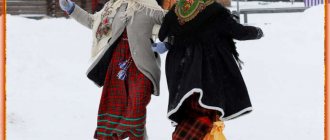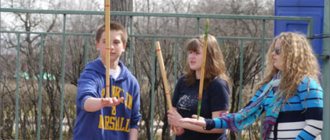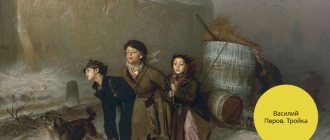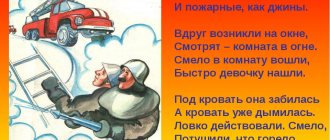MASLENITSA
What did you do on Maslenitsa?
A significant part of the customs for Maslenitsa, one way or another, was connected with the theme of family and marriage relations: newlyweds who got married during the past year were honored at Maslenitsa. The young people were given a kind of viewing party in the village: they were placed at the gate posts and forced to kiss in front of everyone, they were “buried” in the snow or showered with snow on Maslenitsa. They were also subjected to other tests: when the young people were riding in a sleigh through the village, they were stopped and thrown with old bast shoes or straw, and sometimes they were given a “kissing party” or “kissing party” - when fellow villagers could come to the house of the young people and kiss the young woman. The newlyweds were taken for rides around the village, but if they received a bad treat for this, they could take the newlyweds for a ride not in a sleigh, but on a harrow. Maslenitsa week also took place in mutual visits of two recently intermarried families.
This theme is also reflected in specific Maslenitsa customs dedicated to the punishment of boys and girls who did not get married during the past year (in fact, who did not fulfill their life purpose). Similar rituals became widespread in Ukraine and in Slavic Catholic traditions. For example, in Ukraine and in the southern Russian regions, the most famous custom was “pulling”, or “tying” a block, when a guy or girl was tied to a “block” - a piece of wood, a branch, a ribbon, etc. - and forced to walk with it for some time. To untie the block, the punished were paid off with money or treats.
The most important day of Maslenitsa week was Sunday - the ritual before the start of Lent. In Russia, this day was called Forgiveness Sunday, when close people asked each other for forgiveness for all the insults and troubles caused to them; in the evenings it was customary to visit cemeteries and “say goodbye” to the dead.
The main episode of the last day was the “farewell to Maslenitsa,” often accompanied by the lighting of bonfires. In Russia, on this day they made a stuffed Winter from straw or rags, usually dressed it in women's clothing, carried it through the entire village, sometimes placing the stuffed animal on a wheel stuck on top of a pole; leaving the village, the scarecrow was either drowned in an ice hole, burned, or simply torn into pieces, and the remaining straw was scattered across the field. Sometimes, instead of a doll, a living “Maslenitsa” was carried around the village: a smartly dressed girl or woman, an old woman or even an old drunkard in rags. Then, amid shouts and hoots, they were taken out of the village and dropped there or dumped in the snow (“held Maslenitsa”).
It should be noted here that the concept of the “Effigy of Maslenitsa” is somewhat erroneous, since in reality the effigy of Winter was made, rolled, seen off and burned, but since this action took place on Maslenitsa (that is, a holiday), the effigy is very often mistakenly called Maslenitsa, although this is not true.
Where scarecrows were not made, the ritual of “farewell to Maslenitsa” consisted mainly of lighting communal bonfires on a hill behind the village or near the river. In addition to firewood, they threw all sorts of old things into the fires - bast shoes, harrows, purses, brooms, barrels and other unnecessary things, previously collected by children throughout the village, and sometimes stolen specifically for this. Sometimes they burned a wheel in a fire, a symbol of the sun associated with the approaching spring; it was often put on a pole stuck in the middle of the fire. Among the Western and Southern Slavs, the Russian “Maslenitsa” corresponded to Zapust, Mensopust, Pust and some other characters - stuffed animals, whose “farewell” ended the Maslenitsa week. In the central regions of Russia, “farewell to Maslenitsa” was accompanied by the removal of fast food, symbolizing Maslenitsa, from the cultural space. Therefore, in bonfires they actually sometimes burned the remains of pancakes and butter, and poured milk into it, but more often they simply told the children that all the quick meals were burned in the bonfire (“the milk burned and flew to Rostov”). Some customs were addressed to children and were supposed to frighten them and force them to obey: in the Nizhny Novgorod region, on the last Sunday of Maslenitsa week, a pole was installed in the center of the village, onto which a man with a broom climbed and, pretending to beat someone, shouted: “Don’t ask.” milk, pancakes, scrambled eggs.” Farewell to Maslenitsa ended on the first day of Lent - Clean Monday, which was considered a day of cleansing from sin and savory food. Men usually “rinsed their teeth”, i.e. they drank vodka in abundance, supposedly in order to rinse the remnants of the meager food out of their mouths; in some places, fist fights, etc. were organized to “shake out the pancakes.” On Clean Monday they always washed in the bathhouse, and women washed the dishes and “steamed” dairy utensils, cleaning them from fat and remnants of the milk. Other customs and entertainments of Maslenitsa week included mummers (in Russia, mummers accompanied a stuffed Maslenitsa), driving a “goat” or “goat” (eastern Ukraine), fist fights and ball games (sometimes very cruel and ending in injury), cock and goose fights , swings, carousels, youth parties, etc.
NATIVITY
Christmas is not only a bright holiday of Orthodoxy. Christmas is a holiday returned, reborn. The traditions of this holiday, full of genuine humanity and kindness, high moral ideals, are being discovered and comprehended again these days.
Why are Christmas trees decorated at Christmas?
It is believed that the first undecorated Christmas trees appeared in Germany in the 8th century. The first mention of spruce is associated with the monk Saint Boniface. Boniface read a sermon about Christmas to the Druids. To convince the idolaters that the oak was not a sacred and inviolable tree, he cut down one of the oaks. When the felled oak fell, it knocked down all the trees in its path except the young spruce. Boniface presented the survival of the spruce as a miracle and exclaimed: “Let this tree be the tree of Christ.” In the 17th century, the Christmas tree was already a common attribute of Christmas in Germany and Scandinavian countries. At that time, the Christmas tree was decorated with figures and flowers cut out of colored paper, apples, waffles, gilded items, and sugar. The tradition of decorating a Christmas tree is associated with the tree of paradise, hung with apples.
The success of the Christmas tree in Protestant countries was even greater due to the legend that Martin Luther himself was the first to light candles on the Christmas tree. One evening he was walking home, writing a sermon. The brilliance of the stars twinkling among the fir trees filled him with awe. To show this magnificent picture to the family, he placed a Christmas tree in the main room, attached candles to its branches and lit them. The first Christmas trees were decorated with fresh flowers and fruits. Later sweets, nuts and other foods were added. Then - Christmas candles. Such a load was certainly too heavy for the tree. German glassblowers began producing hollow glass Christmas tree decorations to replace fruit and other heavy decorations.
Christmas wreath
The Advent wreath is of Lutheran origin. This is an evergreen wreath with four candles. The first candle is lit on Sunday four weeks before Christmas as a symbol of the light that will come into the world with the birth of Christ. Every next Sunday another candle is lit. On the last Sunday before Christmas, all four candles are lit to illuminate the place where the wreath is located, perhaps the church altar or the dining table.
Christmas candles
Light was an important component of pagan winter holidays. With the help of candles and fires they drove out the forces of darkness and cold. Wax candles were distributed to the Romans on the holiday of Saturnalia. In Christianity, candles are considered an additional symbol of the importance of Jesus as the Light of the world. In Victorian England, merchants gave candles to their regular customers every year. In many countries, Christmas candles signify the victory of light over darkness. The candles on the tree of heaven gave birth to our all-loved Christmas tree.
Christmas presents
This tradition has many roots. Saint Nicholas is traditionally considered the giver of gifts. In Rome there was a tradition of giving gifts to children on the occasion of Saturnalia. The gift giver can be Jesus himself, Santa Claus, Befana (Italian female Santa Claus), Christmas gnomes, and various saints. According to an old Finnish tradition, gifts are distributed around homes by an invisible man.
Christmas on a silver platter
Christmas Eve is called “Christmas Eve”, or “sochevnik”, and the word comes from the ritual food eaten on this day - sochiva (or watering). Sochivo - porridge made from red wheat or barley, rye, buckwheat, peas, lentils, mixed with honey and almond and poppy juice; that is, this is kutia - a ritual funeral dish. The number of dishes was also ritual - 12 (according to the number of apostles). The table was prepared in abundance: pancakes, fish dishes, aspic, jelly from pork and beef legs, suckling pig stuffed with porridge, pork head with horseradish, homemade pork sausage, roast. honey gingerbread and, of course, roast goose. Food on Christmas Eve could not be taken until the first star, in memory of the Star of Bethlehem, which announced the Nativity of the Savior to the Magi.
And with the onset of dusk, when the first star lit up, they sat down at the table and shared the wafers, wishing each other all the best and brightest. Christmas is a holiday when the whole family gathers together at a common table.
CHRISTMAS POST
November 15 (28) – December 24 (January 6), inclusive
How was the Nativity Fast established?
The establishment of the Nativity Fast, like other multi-day fasts, dates back to the ancient times of Christianity. Already from the fourth century St. Ambrose of Mediodala, Philastrius, and Blessed Augustine mention the Nativity Fast in their works. In the fifth century, Leo the Great wrote about the antiquity of the Nativity Fast.
Initially, the Nativity Fast lasted seven days for some Christians, and a little longer for others. At the council of 1166, which was held under the Patriarch Luke of Constantinople and the Byzantine Emperor Manuel, all Christians were ordered to fast for forty days before the great feast of the Nativity of Christ. Antioch Patriarch Balsamon wrote that “the most holy patriarch himself said that, although the days of these fasts (Assumption and Nativity - Ed.) are not determined by the rule, we are, however, forced to follow the unwritten church tradition and must fast. from the 15th day of November."
The Nativity Fast is the last multi-day fast of the year. It begins on November 15 (28 - according to the new style) and continues until December 25 (January 7), lasts forty days and therefore is called Pentecost in the Church Charter, just like Lent. Since the beginning of the fast falls on the day of remembrance of St. Apostle Philip (November 14, old style), then this post is called Philippov.




